You’re setting up a lush terrarium, thick green moss, dripping leaves, the sound of running water. Then you pause, watching a bright blue dart frog hop under a log.
You imagine a small gecko climbing up the glass nearby. It looks like a perfect scene. But can geckos really live dart frogs?
Geckos and dart frogs usually shouldn’t live together, even though they both like warm, humid spaces. Their tanks, food, and moisture needs overlap, but their behavior and bodies make them poor tankmates in most cases.
It seems peaceful in theory, but in practice, it rarely stays that way.
Why People Want to Keep Geckos and Dart Frogs Together
At first, the idea makes sense. Both animals come from warm, humid places full of plants, vines, and insects. A shared tank could look like a tiny rainforest, alive with movement and color.
Dart frogs are bright, active, and mostly stay on the ground. Geckos climb walls and branches, sticking to the higher levels. So, it feels like they’d naturally avoid each other.

Some hobbyists even imagine a little ecosystem: frogs eat crawling insects near the floor while geckos hunt flying bugs above.
It’s a nice thought, and for a short time, it can seem to work. But behind that calm, green setup are quiet conflicts that can turn dangerous.
How Dart Frogs Live Compared to Geckos
Dart frogs are delicate animals. Their smooth, thin skin soaks up moisture (and chemicals) from everything around them. They need steady humidity around 80–100% and constant access to clean, safe water.
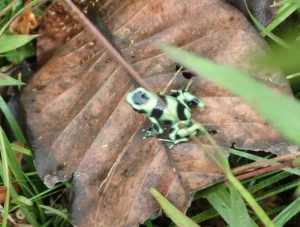
Most geckos, even tropical ones like crested or mourning geckos, need more air and slightly drier conditions. Too much humidity can cause skin problems or bacterial growth.
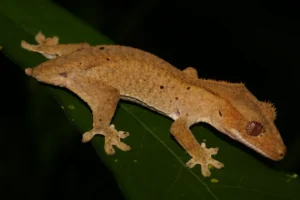
So right from the start, their basic needs clash. A tank perfect for a dart frog can actually be risky for a gecko.
It’s a bit like trying to grow a desert cactus and a water lily in the same pot. Both are plants, but they live by very different rules.
Do Any Gecko Species Tolerate Dart Frog Conditions?
A few might, but not comfortably.
-
Crested geckos (Correlophus ciliatus) – From humid forests, they might handle high humidity for short periods.
-
Mourning geckos (Lepidodactylus lugubris) – Small, sometimes kept in bioactive setups similar to dart frog tanks.
-
House geckos (Hemidactylus frenatus) – Hardy, but they like more airflow and less constant moisture.
Even these geckos face stress long-term in a frog-style tank.
Too much moisture, low ventilation, and competition for food can cause breathing problems, skin infections, or poor appetite. They might survive, but they won’t thrive.
How Each Species Reacts to Space and Territory
In the wild, dart frogs claim small patches of forest floor and guard them from intruders. Geckos do the same, especially males protecting feeding and basking spots.

When two territorial animals share a small tank, tension builds fast.
You might not see open fighting right away, but subtle signs appear: dart frogs hiding more, refusing food, or geckos pacing near the glass. That’s their way of saying the space feels wrong.
Stress like that can lead to illness, infections, or even death for one or both animals.
What Happens When Geckos and Dart Frogs Compete for Food?
Both eat small live insects such as crickets, fruit flies, springtails, and other tiny bugs. In a shared tank, that becomes a problem.
Geckos are faster hunters. They grab insects before dart frogs even notice. Frogs end up eating less, losing weight and energy while the gecko grows stronger.
Sometimes, a gecko might even mistake a frog’s movement for food and bite it.
Their jaws aren’t for killing frogs, but a bite can tear sensitive frog skin or spread bacteria. Dart frog skin is delicate and absorbs bacteria easily.
Even if no one gets hurt, just competing for food adds stress to both animals, enough to shorten their lives.
Can Dart Frogs Hurt Geckos?
It might sound surprising, but yes, they can.
Captive-bred dart frogs no longer produce strong toxins like wild ones, but they can still secrete mild skin chemicals that irritate reptiles. If a gecko licks or touches a frog during feeding, it can absorb these chemicals and get mild poisoning.
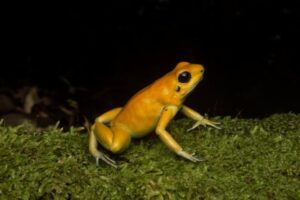
Dart frogs can also carry tiny bacteria and parasites that don’t harm them but can bother geckos. Damp conditions make these microbes grow faster.
Even if the frog doesn’t mean harm, its presence can make the tank unsafe for a gecko.
What Happens When People Try to Keep Them Together?
Some keepers have tried, usually with mourning geckos and small dart frogs. At first, it can look like success, both active and eating well.
But after weeks or months, problems show:
-
Geckos hide more or shed poorly from high humidity
-
Dart frogs eat less and stay under leaves
-
Mold or fungus builds faster with both animals in a closed space
-
Small feeder insects disappear before frogs can catch them
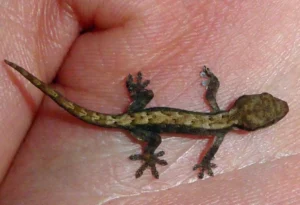
By the time keepers separate them, one animal is usually weaker or showing early illness. It’s slow but damaging. Experienced herpetologists almost always recommend keeping them apart.
Why a “Natural” Shared Setup Doesn’t Always Mean a Healthy One
People assume that because both animals live in rainforests, they share the same microhabitats. But rainforests cover a huge range; from dry canopy to wet forest floor.
Dart frogs live low, in constantly moist leaf litter. Geckos prefer branches or trunks with more air.
Even in nature, they barely meet. Putting them in the same tank forces two different worlds into one tiny space.
A terrarium might look natural (with moss, leaves, and mist) but unless every little condition matches each animal’s needs, one will always pay the price.
Could a Very Large Tank Make It Work?
Maybe, but only for expert keepers, and even then, it’s risky.
To give both species enough space, you’d need at least a 120–150 gallon tank with strict separation between upper and lower zones.
-
Bottom: wet and full of plants for dart frogs
-
Top: drier branches, good airflow, and warmth for geckos
Automatic misting, drainage layers, and constant monitoring would be essential.
Even then, problems can happen: the animals can meet while hunting, geckos might jump down, or drink contaminated water. Success isn’t guaranteed, even for skilled keepers.
How Stress Shows in Geckos and Dart Frogs
Stress can be quiet, easy to miss.
In geckos:
-
Eating less or refusing food
-
Hiding all day, even at night
-
Shedding problems or dull skin
-
Constant pacing or climbing glass
In dart frogs:
-
Staying in one corner or under leaves
-
Fading colors
-
Jumping nervously at movement
-
Loss of appetite or thin bodies
These signs show the animals feel wrong in their space. Small infections or parasites can turn serious fast.
The Safer Alternative: Separate but Connected Habitats
If you love the idea of seeing both species together, try two tanks side by side.
You can match rainforest themes (plants, moss, branches) so it looks like one big world, but each animal has its own safe space.
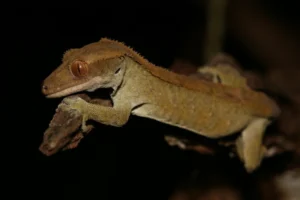
This way, you can fine-tune temperature, humidity, and lighting for each species. Geckos get drier perches and nighttime heat, frogs enjoy steady misting and moisture below.
It still feels like a shared ecosystem, but invisible boundaries keep everyone healthy.
Are There Any Reptiles That Can Live with Dart Frogs?
Not really. Dart frogs are safest alone or with their own kind. Their sensitive skin and microclimate make mixed tanks risky.
Small creatures like springtails, isopods, or tropical snails can help as “clean-up crews.” They break down waste without bothering the frogs.
Geckos do best alone too. Even two together can fight or lose tails if space or food is limited.
The best mix is one species per tank, with tiny helpful insects filling the background.
Why Separation Is Kinder, Not Boring
Keeping just one species might seem less exciting, but it lets you see real behavior.
Dart frogs hop freely, call, and explore. Geckos climb confidently, eat well, and show bright colors.
Together, they hide and compete. Apart, they come alive.
Separate tanks aren’t about restriction, they’re about comfort and safety.
What About Pet Stores or Photos Showing Them Together?
Sometimes pet shops or social media show frogs and geckos sharing a tank. These setups are usually staged for photos or short-term displays, not long-term homes.
The animals might stay hours or days before being moved. It looks pretty, but it’s not healthy.
Always look for long-term success stories, not snapshots. Most mixed setups lead to one animal quietly struggling.
How to Choose Which Pet Fits You Better
If you’re torn, think about your own style:
-
Dart frogs – quiet, active in the day, fun to watch, vivid colors
-
Geckos – curious, mostly active at night, enjoy climbing and gentle handling
Both need care, but reward you differently. Choosing one doesn’t mean giving up the other, you can admire both in separate, well-designed tanks.
Frequently Asked Questions
Do geckos and dart frogs get along?
Not really. Geckos and dart frogs have very different behaviors and needs.
Geckos can be curious and might try to eat smaller frogs, while dart frogs can be stressed by bigger, fast-moving tank mates.
Can geckos and dart frogs live in the same tank?
It’s generally not a good idea. Their diets, humidity, temperature, and space requirements don’t match well.
Geckos might hunt the frogs, and dart frogs could become stressed or even injured.
Are geckos and dart frogs compatible as tank mates?
No, they aren’t compatible. Geckos are often larger, nocturnal hunters, while dart frogs are tiny, diurnal, and very sensitive to stress.
Housing them together usually leads to problems for one or both species.
Why shouldn’t geckos and dart frogs be housed together?
Because of risk of predation, stress, and differing environmental needs.
Geckos might see dart frogs as prey, and dart frogs can’t tolerate the same temperature or activity levels that geckos do.
What happens if a gecko and dart frog share the same enclosure?
The most likely outcomes are stress for the dart frogs, possible injury or death, and poor overall health for both animals.
Even if nothing dramatic happens immediately, it’s unsafe and can lead to long-term problems.
Conclusion
Geckos and dart frogs may both like humidity and insects, but they live by different rules.
Dart frogs need constant moisture and clean air on their delicate skin. Geckos need airflow, dry surfaces, and room to move. Their worlds overlap just enough to make the idea tempting, but not safe.
A shared tank might look peaceful at first, but stress builds quietly until one fades.
So the answer is simple: no, geckos and dart frogs shouldn’t live together.
They can still share your space, in separate worlds that let each thrive.
Hi, my name is Ezra Mushala, i have been interested animals all my life. I am the main author and editor here at snakeinformer.com.

